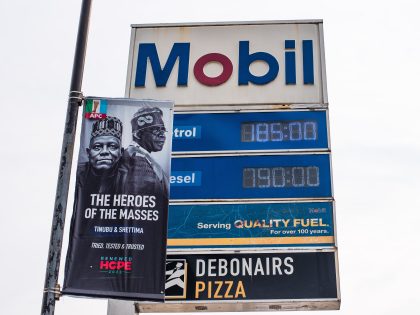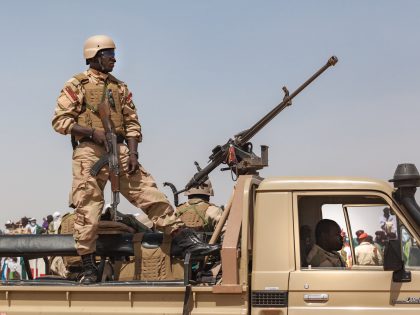Living up to its Pan-African dimensions
Filmmakers Newton Aduaka and Haile Gerima and film critic and scholar, Mbye Cham, assess Fespaco 2013.

A still from "Aujourd'hui."
The 23rd edition of the famed West African film festival FESPACO ran last month in Ouagadougou, Burkina Faso. Since the festival, we asked two filmmakers — Newton Aduaka (who attended) and Haile Gerima (who stayed away) — and one film critic and academic, Mbye Cham (who served as president of the Official Jury for Long Feature Films at FESPACO in 2011), to give us their respective takes on the festival.
First up is Professor Cham, who is chair of Howard University’s African Studies Department and who has published widely on themes related to African film. How long have you been attending FESPACO? And what did you think of it this year?
The first time I went to FESPACO was in 1985 and that was through my colleague at Howard University, Haile Gerima, who was on the jury at the one prior to the 1985 edition, in 1983. He was very impressed with what he saw going there. He came and mobilized some of us to think about going to the following edition in 1985. That was the time when we got together and got the first delegation for the first edition of African American filmmakers to go to FESPACO. Along with that, there was a symposium also organized at the university of Ouagadougou that explored relationships and partnerships between African filmmakers and African-American filmmakers. A couple of projects came out of that particular encounter. It opened up FESPACO to the broader diaspora, and made it live up to its Pan-African dimensions. One of the important outcomes of that particular trip was the establishment of the Paul Robeson Prize.
Over the years, the festival has changed dramatically. This year, the festival was much, much better organized. Part of the whole thing about FESPACO is that, year after year, the same old problems kept cropping up. But this year, amazingly, I did not hear anybody complain. At least not to me. I didn’t overhear the usual complaints about people not getting hold of their badges, the program not being ready. There were a few cases where a couple of filmmakers were complaining about the conditions of the screenings of their films. But, on the whole I thought this year’s festival was much better organized. The selection was also a lot better, in terms of the quality, the diversity and the themes and subject matter were quite interesting.
Did you hear some complaints about the 35 mm rule (that is the festival organizers’ decision to only accept films shot on 35mm)?
That’s one of the perennial issues that FESPACO has had to deal with. It’s not just an issue with Nigerian films, but really with Anglophone films. Because for a long time, the Anglophones have felt marginalized. The festival is still pretty much Francophone heavy. And, there needs to be some type of balance. This year definitely was no exception at all. Even though in the main competition, there was a film by a Nigerian, Newton Aduaka. He’s a Nigerian but living in Paris. The sort of films that you see very popular today in West Africa, and perhaps globally, are the so-called Nollywood films. These are a market absence in selection at FESPACO. The one that would come nearest to that would be the Ethiopian film Nishan.
In 2011, I was the President of the Jury. One of the films that we had a lot of discussions about was the film Le Mec Ideal, by the director from Côte d’Ivoire, Owell Brown. It’s a film that departs from your normal, dominant discourse and one that came a little closer to the Nollywood narrative. It showed that it was time for FESPACO to open up. This film ended up receiving the bronze.
How do you think that politics plays into the festival, in the context of Thomas Sankara’s assassination and of Blaise Compaore, a kind of “life president,” who is blamed for his murder, as a major benefactor of the festivities?
The nature of African politics is that [laughing], as you know very well, that these “Presidents for life” are a part of the reality that unfortunately defines many political landscapes in Africa. Yes, Compaore has been there since 1987. And what are the prospects of him exiting peacefully? Well, again, it’s anybody’s guess. We don’t know. There are signs that he might be leaving soon. I don’t think he has anything to do really with the actual selection of the films. I’m sure that there’s an awareness of his likes and dislikes, but I don’t think those factor in at all in terms of the selections.
How do you feel about other African oriented festivals that are spreading in the US?
It helps. Any opportunity to showcase these films, which have a difficult time circulating in the normal circuits, helps. As our friend Clyde Taylor used to point out, the paradox is that you have more festivals in the US devoted to African cinema than to African-American cinema. “Why,” is another question. The festivals and similar events that take place in the US are in no way in competition with FESPACO. I think they reinforce and compliment each other.
And what about the rising number of festivals in North Africa?
Well, I don’t think they are (competing). FESPACO has institutionalized itself in the cultural film calendar in Africa to such an extent that you have all these other festivals going on but I don’t think people are quite at that point where they’re ready to throw FESPACO overboard. To me it is still the festival as far as African cinema is concerned. You have a lot of others that are happening in Southern Africa. In South Africa in particular, there’s the Durban Film Festival. You may have some festivals in East Africa. The Nigerians have their own. But, to date I don’t think any of them have dislodged FESPACO as the premier venue for African cinema. For the future, I don’t know. But for now… it hasn’t been the case yet.
South Africa has been a go-to country for some large-scale Hollywood productions. How do you feel that has played a role in South Africa’s efforts to grow its film industry?
Historically, if you look at the situation in South Africa as far as film is concerned, that historical domination by Hollywood is still there to a large extent. So that a lot of the films that have made it internationally outside of South Africa tend to be films that adopt Hollywood formulas. The few that are really in the same mold as the ones that you see in other parts of Africa are there, and have some merit, mostly by Black filmmakers. But those have rarely been given the recognition that they deserve outside of South Africa. South Africa is still operating under conceived conventions of what cinema is. One can trace the origins of that to the apartheid days and the dominance of Hollywood on the industry there.
Next up is Haile Gerima, the director of the epics “Teza” and “Sankofa” and the co-owner of Mypheduh Films.
Why have you decided not to attend FESPACO?
I don’t go to FESPACO because it’s become a circus without objectives. It’s like all other festivals, without the initiatives and objectives it was created under. Why not just go to a white festival? Why still be the “other” in that mess? The country shouldn’t even have the right to sponsor this type of festival. They assassinated a human being. There should be a Sankara/Compaore documentary to explore that.
Finally, here’s Newton Aduaka, the Paris-based director Newton who was the only Nigerian to attend this year’s festival with his film, One Man’s Show, starring Emil Abossolo-Mbo.
How was it to attend this year’s festival?
As always, the run up to the festival was hectic. I had quite a bit of work on my hand completing the post-production of One Man’s Show with my co-producers, Centre Cinematographique Marocain, at their labs in Rabat, Morocco. They were very kind to jump in at the last moment to help in preparing the infamous 35mm print as the film was in competition. It was exciting being back in FESPACO again.
How did you feel about “Aujourd’hui” getting the Etalon D’or?
As you know, “Aujourd’hui” was co-produced by Granit Films, Paris; the production company owned by Alain Gomis, Valerie Osouf, Delphine Zingg and myself. We are very proud that the film won the Etalon D’or, and deservedly so for Alain. With “Aujourd’hui” Alain explored a complex in-between space; between life and death, metaphysical and the real, home and away, the link between the here and hereafter, etc but in a very poetic and personal way. I am happy that Alain got the recognition he rightly deserves.
I’ve read reviews of FESPACO (here and here) that complain that not more Nigerian, or rather Anglophone, filmmakers could be involved in the competition because they did not shoot or print on 35 mm film. Do you think that rule should change? Or rather, do you think that the competition is fairly open?
I believe that that rule has been scrapped. From 2015, films in competition can now be shown on DCP (digital cinema packages) as well. This is a concession that goes some way towards addressing the long pressing issue of FESPACO embracing digital projection. African filmmakers are some of the least underfunded filmmakers in the world and shooting or printing film on 35mm is a very costly process which most of us cannot afford. It has become a trap that has in the past excluded certain films that should have been in competition; a loss to the festival and disappointment for the filmmaker. I must clarify here that though the old rules said that films must be shot in 35mm, some of the films in past competitions were shot in digital and then transferred to 35mm print. Though a cheaper route to a 35mm projection than shooting the entire film on 35mm or Super 16 for that matter, it no less set those filmmakers back near €30,000. The restriction no longer makes sense; hence I appreciate the new rule. If filmmakers can afford to shoot on film, great, but if not, then we can now be honest with the digital process and go digital all the way. I hope that this debate of medium, of celluloid/digital, can now be put to rest so that we can focus on the more important matter of discussing the craft of cinema, form and content, especially the latter.



















